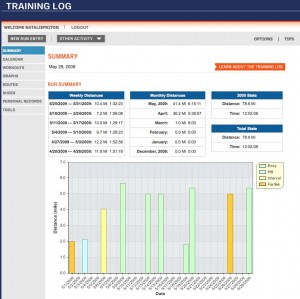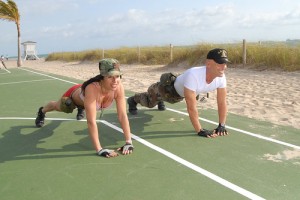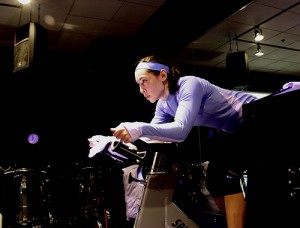I hit 30 weeks yesterday, on July 4. A day when I can distinctly recall running in early morning shaded routes to get the run in before the big party. Last year I remember running in 100% humidity and high heat doing track work as part of marathon training. I remember Fourth of July runs just for fun, because its a holiday, and why not? This year, there was no run for me. Continue reading
Tag Archives: Spinning
The 9+ Minute Mile is Here
At the end of 15 weeks I went out for a three mile run and didn’t pay too much attention to my pace though I could feel that it was slow. I thought for sure I’d average out at 9:30 for that short run. It was an early run, before sunrise, and there is no doubt the morning run is still the way to go (vs running midday). I was pleasantly surprised to find that my average pace for that run was 8:58/mile, just squeaking in below 9 minutes.
My new weekend routine is now that I go for a bike ride on Saturday afternoon while our son naps and then an early long run on Sunday. I like this routine quite a bit. The cycling is helping me train for Tour de Cure in May where I’m really hoping I can hang for 32 miles. The Sunday run is a 6.8 route with a flat stretch until the halfway point where there also happens to be a ranger station along the B&A trail with restrooms. Enough said. The second half of the loop is a perfect hilly mix and for probably any number of reasons is typically faster than my first half. Pregnant or not, I usually need a couple miles to warm up so I inevitably end up with negative splits more often than not. This makes for a very satisfying run.
Slow and Steady
 Even though that recent 3 miler was a hair under 9 minutes, I have a feeling that may be the last time that happens for the next 5 months. My long run averaged out at a 9:38/mile pace. I proclaimed a few weeks ago that I wanted to maintain sub-9s for as long as possible, at least on the shorter runs. I now know what “as long as possible” equates to. At 16 weeks pregnant, my new pace is slow and steady. I am hoping, however, that I can still finish the next 10k race in under an hour. At the 6.2 mark on the long run my time was 58:38, so we’ll see. Two more weeks could make a big difference in how I perform, even in the spirit of race day.
Even though that recent 3 miler was a hair under 9 minutes, I have a feeling that may be the last time that happens for the next 5 months. My long run averaged out at a 9:38/mile pace. I proclaimed a few weeks ago that I wanted to maintain sub-9s for as long as possible, at least on the shorter runs. I now know what “as long as possible” equates to. At 16 weeks pregnant, my new pace is slow and steady. I am hoping, however, that I can still finish the next 10k race in under an hour. At the 6.2 mark on the long run my time was 58:38, so we’ll see. Two more weeks could make a big difference in how I perform, even in the spirit of race day.
I got curious though to compare my distances and paces from this current pregnancy with round one. The biggest difference is that I went into that pregnancy marathon ready and into this one barely half marathon ready but with speed like I’d not had before. In 2011 I finished the Marine Corps Marathon at the end of my first trimester. From there I kept up with 3-6 mile runs until about week 18 but I was averaging 10+ minutes per mile. In comparison, I’m currently only running 2-3 days a week, with those runs also 3-6ish miles (plus 2 days per week spin/cycle and cross-train), but I’m a solid minute faster at the same point in pregnancy than the first time. Just interesting.
And regardless, the point is to stay fit, keep exercising, keep running and keep moving. One week at a time.
The Early Weeks
I’m somewhere around 5 weeks as I write this post and am having many mixed emotions. Excited about baby number two, fearful of losing my fitness, all that I’ve trained for and the work I’ll have to do to get it back but also ready for the challenge of making it all work. I said in the very first post in this series to keep it honest. So that’s what I’m doing here, for better or for worse.
One common piece of advice to pregnant women with regard to staying fit is that you should be able to continue doing the same things you did pre-pregnancy during pregnancy. So if you were always a runner, keep running. If you bike, keep biking. If you did pilates or yoga, keep at it.
In my particular case, running is my “go to.” I was always running pre-pregnancy so I will continue to run throughout pregnancy. What is holding me up this time, is that I didn’t go into this one in marathon shape; half marathon shape at best. My longest run in December was 7 miles. I had high hopes of taking on a pregnant half marathon in March, just to do it, but with each run I am trying to rationalize with myself that 10ks are a smarter choice if I have to race. I am hopeful to maintain my 3 days a week of running and use one of those as a weekend long run, preferably staying in the 7-10 mile range for as long as possible. The frustration I have is that even in these early weeks I can already feel a little more challenge in the runs. Maybe not so much a challenge as an innate understanding that I need to go slower. I mentally want to push myself for my sub-8 minute pace but the last few runs it’s just not been the right thing to do. I want to warn runners that if you had been used to pushing yourself, to doing speedwork, tempos, hill work, training for a pace–it all changes. There is a major shift in what your body will allow (and want) you to do comfortably. And it is ALL mental. If you think hard enough about while you’re running, you can stop focusing on pace and just enjoy running. I know I sound like I’m complaining. And I also realize this makes it sound like “running just to run” isn’t worth it but for me it is a readjustment. For the next 8 months I cannot consider running a competitive outlet. It simply as to be my outlet. It will keep me grounded, keep my mind clear, give me fresh perspective, and hopefully help keep me in shape to bounce back fast.
I also went into this pregnancy with a tiny bit of cross-training under my belt and I knew full well that if I was in shape to do certain things pre-pregnancy that I could continue doing them throughout pregnancy. These last few weeks I have been pushing it a bit to “get in” more cross-training in the early weeks so that I can tell myself I can continue to do these things for the next 8 months. I took back up rowing 1-2 times per week with my mini circuit training of squats, lunges, push-ups and core work. I added in a spin class once a week at a new spin studio in Baltimore (which is awesome by the way, check it out: Revuup). I also took on yoga for runners with three different videos on RW.com hosted by Rebecca Pacheco.
The early weeks are hard. They’re hard because they’re so early that you’re not supposed to tell anyone you’re pregnant so you feel like you’re keeping a secret and yet all you want to do is shout it out. They’re hard because you want to keep doing everything you would normally do but you’re not sure of any new limitations. They’re hard because depending on the woman and pregnancy, you may be zapped of energy to even think about staying fit. They’re just hard. But perhaps they’re also the ideal challenge to see what you’re capable of powering through.
If you’re in your early weeks of pregnancy and feel like it’s just hard, I understand. If you wish you could run faster again, I hear you loud and clear. But keep running. And stay honest!
P.s. This post was written January 15 and held for a post-date publication until we were in the “safe zone.”
Pulling Up, Spin Class Tactics
 With all the snow on the ground and the need to log time on the bike, spin class is an ideal solution for getting in a good ride. In fact, I probably push harder in spin class than I do when I’m out riding on my own. There is a trained instructor who guides an intense work-out and the combination of hills, surges, speedwork, lifts, and steady climbs makes for an incredible 60 minutes on the stationary bike; plus there is the added bonus of what are usually great playlists made by the instructors!
With all the snow on the ground and the need to log time on the bike, spin class is an ideal solution for getting in a good ride. In fact, I probably push harder in spin class than I do when I’m out riding on my own. There is a trained instructor who guides an intense work-out and the combination of hills, surges, speedwork, lifts, and steady climbs makes for an incredible 60 minutes on the stationary bike; plus there is the added bonus of what are usually great playlists made by the instructors!
Though I’ve been attending spin classes for a few years now, I do not consider myself an ‘advanced level’ spinner. I only go 1-2 times each week and I have very specific goals each time I go. 1.) Build better endurance to use the higher gears longer and 2.) Improve my form. I am sure there are plenty of articles and blogs out there with great advice on how to achieve these things and I will definitely be seeking them out. In the meantime, I thought I’d share the few things I’ve figured out that seem to be effective spin class tactics. Continue reading
Training Log Review: Runner’s World
 For the last month I have been using the training log on runnersworld.com both to log my work-outs as well as to experiment with one of the many available online training log programs available to athletes. It was a few months ago that I decided I would use and review as many logs as possible and I had started with the log on Race Nation‘s website before moving on to the Runner’s World log.
For the last month I have been using the training log on runnersworld.com both to log my work-outs as well as to experiment with one of the many available online training log programs available to athletes. It was a few months ago that I decided I would use and review as many logs as possible and I had started with the log on Race Nation‘s website before moving on to the Runner’s World log.
When I started with the RW log, I was slowly building my running routine back up from my marathon recovery and have since begun training for my first triathlon, so I have multiple kinds of work-outs that I need to track. I already had a profile on rw.com, but if I hadn’t, that would have been the first step, just like for any other site that stores your personal information.
The RW log has one button to enter a new run and another button that drops down with options to enter a bike, swim, strength session, walk, health note, or generic ‘other’ work-out. I found entering the first few entries to be tricky because not all fields of the log format were super intuitive to me. For most type of work-outs, standard data fields are: date, time, heart rate (rest, average, and max), route, distance, time, weight, and environment. There is also a standard notes box at the end, which I love, as well as the option to rate the quality and effort of the work-out on a scale of 1 to 10 with 10 being the best or hardest. And, as you may know, I am a big fan of measuring the quality of my work-outs. Continue reading
What Are All These Thresholds?: Lactate Threshold
If you spend enough time training for anything and start to read articles, message boards, and blogs that discuss your specific exercise be it running, biking, spinning, or swimming you are bound to come across a discussion about lactate threshold. It’s likely you will see this phrase used in conjunction with topics of heart rate training, VO2 max, aerobic and anaerobic metabolism, and perhaps even endurance zones. Unless you have a degree in sports or fitness or are a trained trainer, these words probably read like a foreign language and feel overwhelming.
At least that’s how I felt.
What better way to eliminate that stressed feeling of not understanding all this new training lingo than to learn as much as possible about it? There are endless resources on the topic of lactate threshold but before we get into how it relates to training, some basic definitions would be helpful to outline. Continue reading
Measuring Work-out Quality
I’m on the second week of training for a triathlon which includes two cycling sessions per week. Until now I’ve been going to spin class and needed to start biking outside. I broke out my Gary Fisher mountain bike, checked that the tires had enough air, and headed out for the 40 minute foundation ride the training schedule called for.
Most of the areas where I live that I can bike are relatively flat. I try to incorporate hills into my runs whenever I can and I chose to do the same thing with my bike ride. Even with the hills and keeping the mountain bike on has hard of a gear as I could handle, I felt pretty disappointed at the end of the 40 minutes with the quality of the work-out. Thank goodness I can push myself hard with ab exercises or I would have felt as though I’d done hardly anything.
Spin class to me is possibly one of the best work-outs I do. I think this because I sweat a tremendous amount in the class, I breathe hard, and I know that I am challenged in each class. When I enter spin classes in my training log, I always rate it with a high quality level, usually a 6-8 on a scale of 10. As I was putting my bike away and noticing how little I had sweat, I started thinking about the process and components I use to measure the quality of a work-out and wonder how you think about work-out quality. Continue reading
Thresholds: Heart Rate Help
 At the suggestion of a friend of mine who is an NSPA-certified instructor, I got a Polar heart rate watch last fall to help me train better. I read the Polar user manual and it was obvious the watch does a lot more than what I am ready to do in my training (different alarms for speedwork, a variety of lap settings, etc), and while I haven’t delved into the watch’s many functions, I did set it up to monitor my heart rate. My “own zone” is 65-85% of normal heart rate and I am almost always above the max.
At the suggestion of a friend of mine who is an NSPA-certified instructor, I got a Polar heart rate watch last fall to help me train better. I read the Polar user manual and it was obvious the watch does a lot more than what I am ready to do in my training (different alarms for speedwork, a variety of lap settings, etc), and while I haven’t delved into the watch’s many functions, I did set it up to monitor my heart rate. My “own zone” is 65-85% of normal heart rate and I am almost always above the max.
I thought maybe it would be helpful to switch from the percent of heart rate to the actual heart rate setting thinking I would have a better idea of how I’m doing if I knew my actual heart rate. I do like seeing the HR rather than the percent of HR, however, I’m still not clear on what the numbers actually mean. For example, I did a 4.05 mile run with the watch beeping at me almost the entire time. My HR limits were 162/124 and I was only in my zone for 8 minutes of that run. Oddly, the rest of the time I was below my zone with an average HR of 120 despite the fact that my time on this run was the fastest I’ve had yet for that route. How could my HR have been so low when I was actually running faster?
Realizing the number of questions I have, I decided it was time to do some more reading. I turned to Polar’s website as well as an extremely helpful document called Optimal Results, a heart rate training program that was developed in 1994 by Dave Ruff, the National Personal Training Director for TFC Partners and owner of Ruff Fitness. In reading through the training articles on Polar’s website, I learned that I probably should first monitor my resting HR and then set up my own limits based on that number in order to properly conduct heart rate training. Continue reading
Mixing It Up: Spinning & Strength Training

Our tricep push-ups did not look this hard core, but the form is still the same. Photo by Colonel Bob.
When I first started going to spin class I thought for sure I wouldn’t last. I thought I might get bored or never build up a tolerance for the intense work-out it provides at the crack of dawn. Now I’ve already lost track of how many classes I’ve gone to (though I could check it in my Runner’s World training log) and I have come to appreciate the intensity of spinning and I am certainly not bored. Just as no one run is the same, neither as any one spin class and it’s not just because of having different instructors. The class is entirely about what you put into it, how much extra gear you’re willing to add to your bike, and how hard you’ll try to sweat a little more each time.
The variety of spinning is what keeps me coming back and I recently got even more than I bargained for with a fantastic instructor. She called the course SSOB–Spinning Strength Off Bike. Normally the courses run for a full 60 minutes of spinning. According to the triathlon training schedule I’m using I technically only needed a 35-40 minute foundation ride, meaning a ride at a moderate pace. I figure it’s in my favor in the long run if I can already ride longer and at a higher intensity. This course gave me a good 40 minutes of spinning in addition to a strength work-out which I have been somewhat neglecting.
For 20 minutes we did sprints, out of the seat sprints, a seated climb, and a series of 20 second sprints at gear 6 with 20 seconds of rest. Then it was off the bikes and over to the wall. Continue reading
Putting Sprints Into Perspective
I have been trying to go to spin class at my gym at least once a week, twice if my body can handle the early morning wake-up; class starts at 5:30 a.m. By now I have had every instructor and they each have their own teaching style, routines, and way of motivating me to push just a little harder than I think I can. Some focus more on out of the seat drills, others prefer hills or using more gear for resistance, and now I’ve worked with the instructor that favors sprint intervals.
Her theme for the class was to “put the sprints in perspective.” At first I could not really decide what that meant but by the end of the class I liked the phrase a lot and felt as though we did indeed put the sprints in perspective. When I first started spinning I had to concentrate so hard on pedaling, breathing, and my form that I really didn’t pay too much attention to the routine, I just did as I was told. Now that I have a good chunk of sessions under my belt, I must be getting a little better because I finally retained most of the drills. Continue reading



